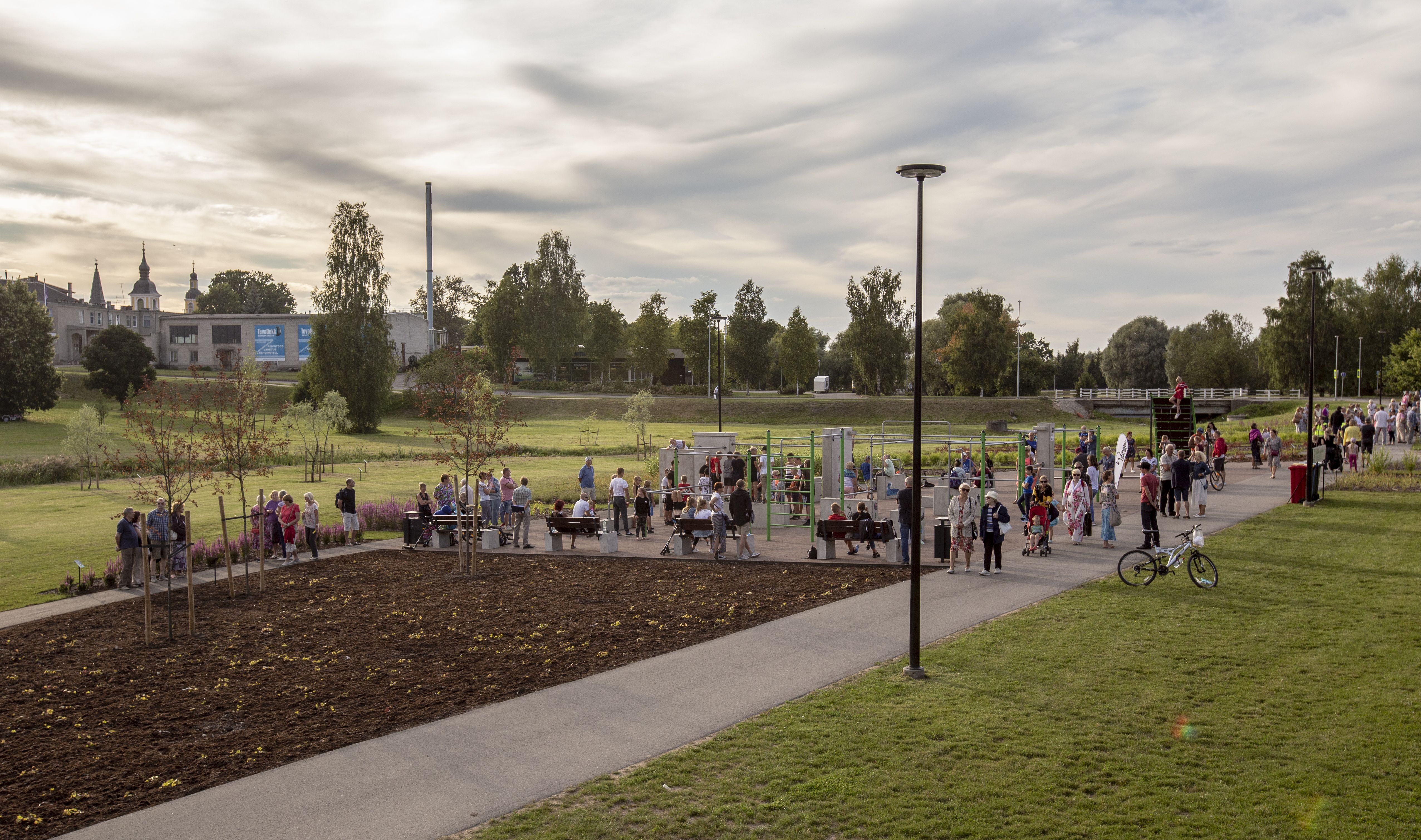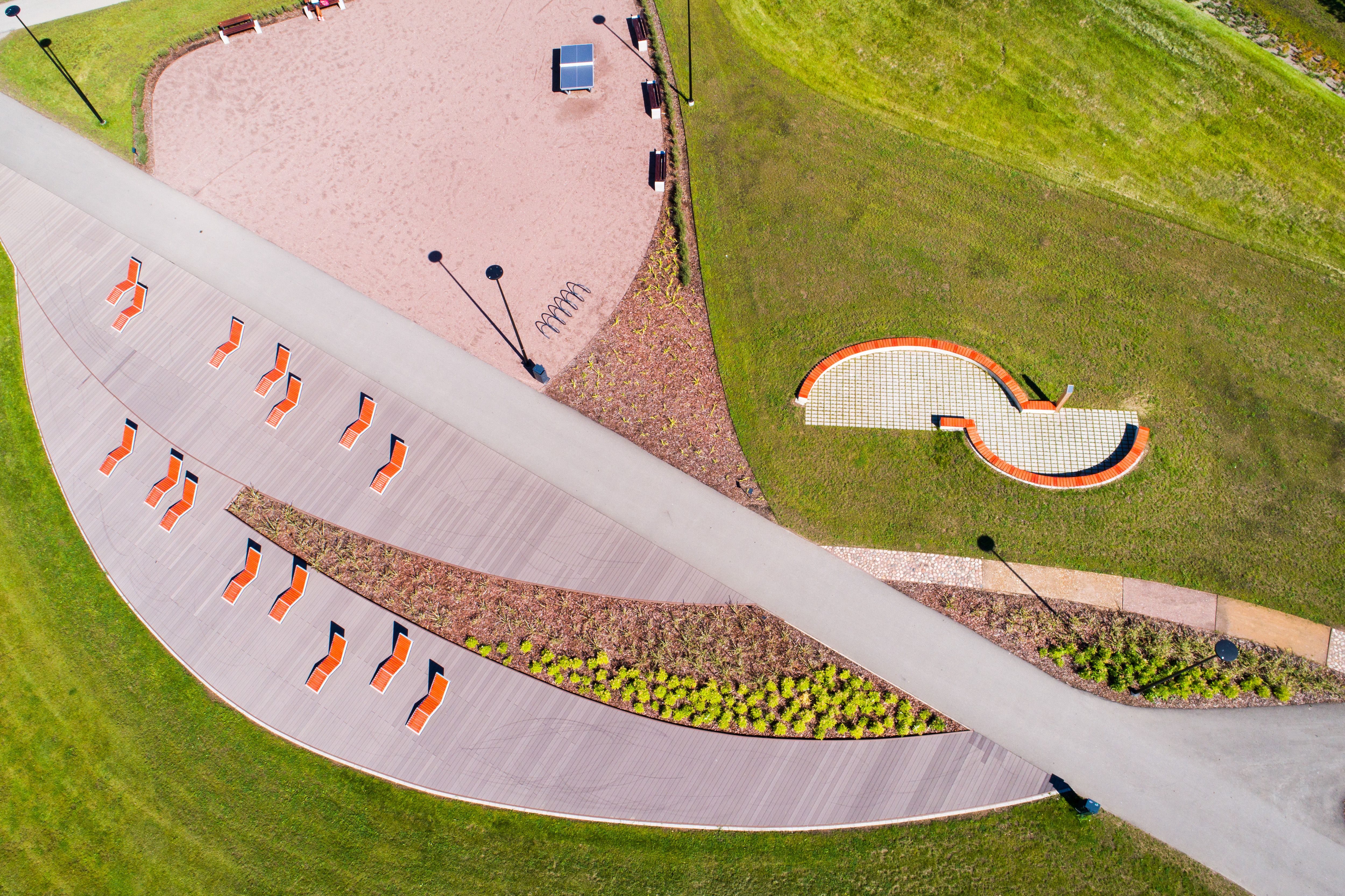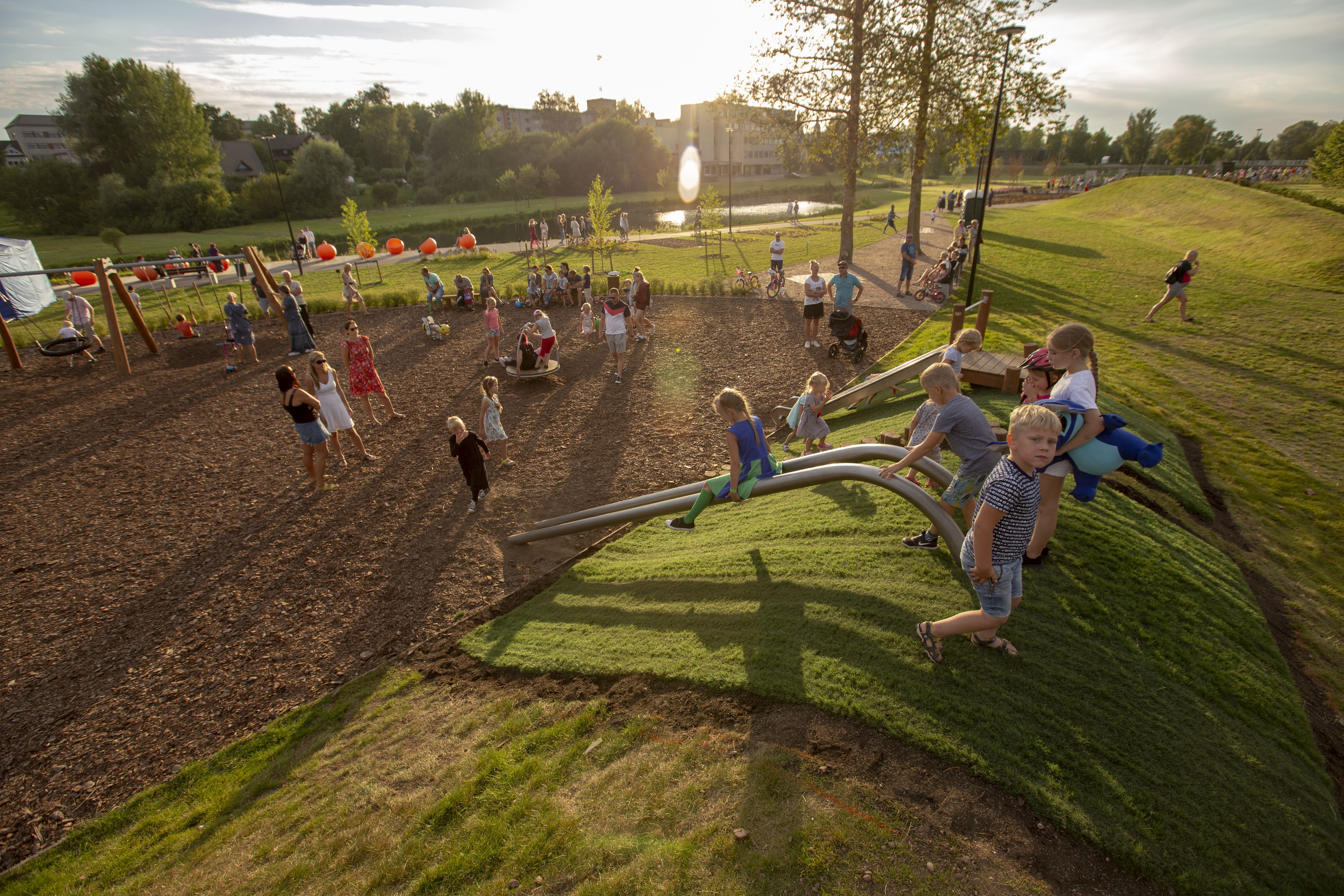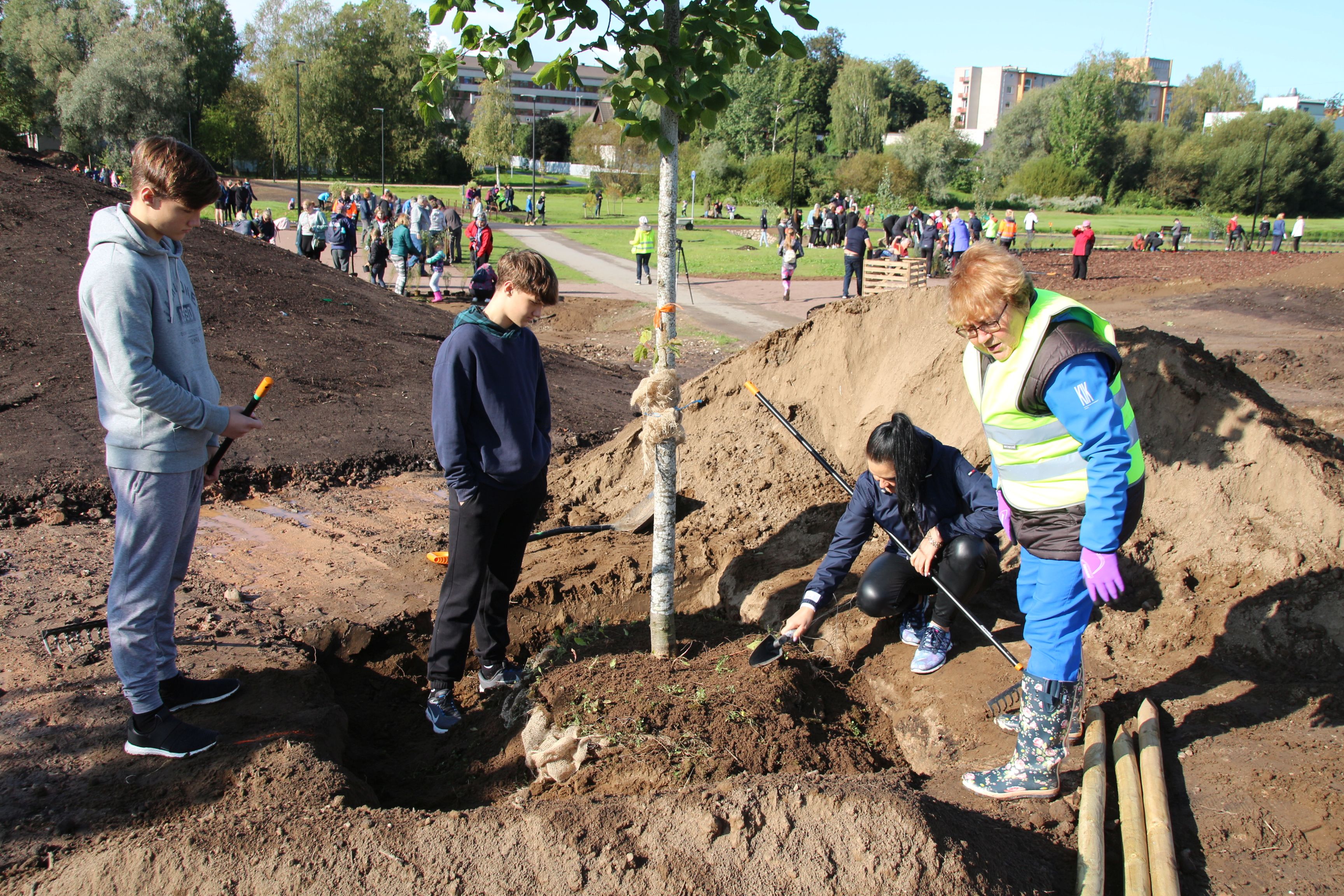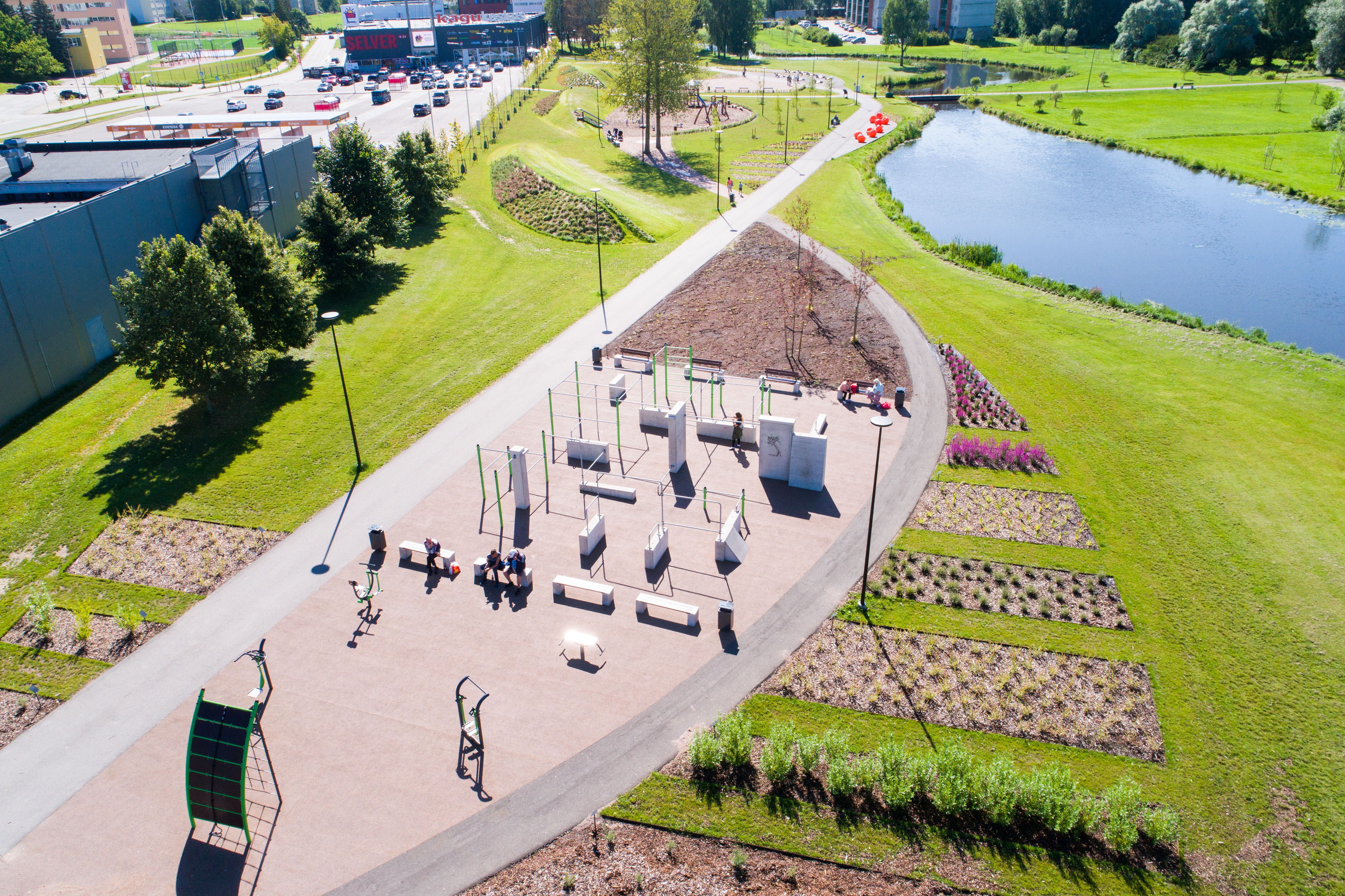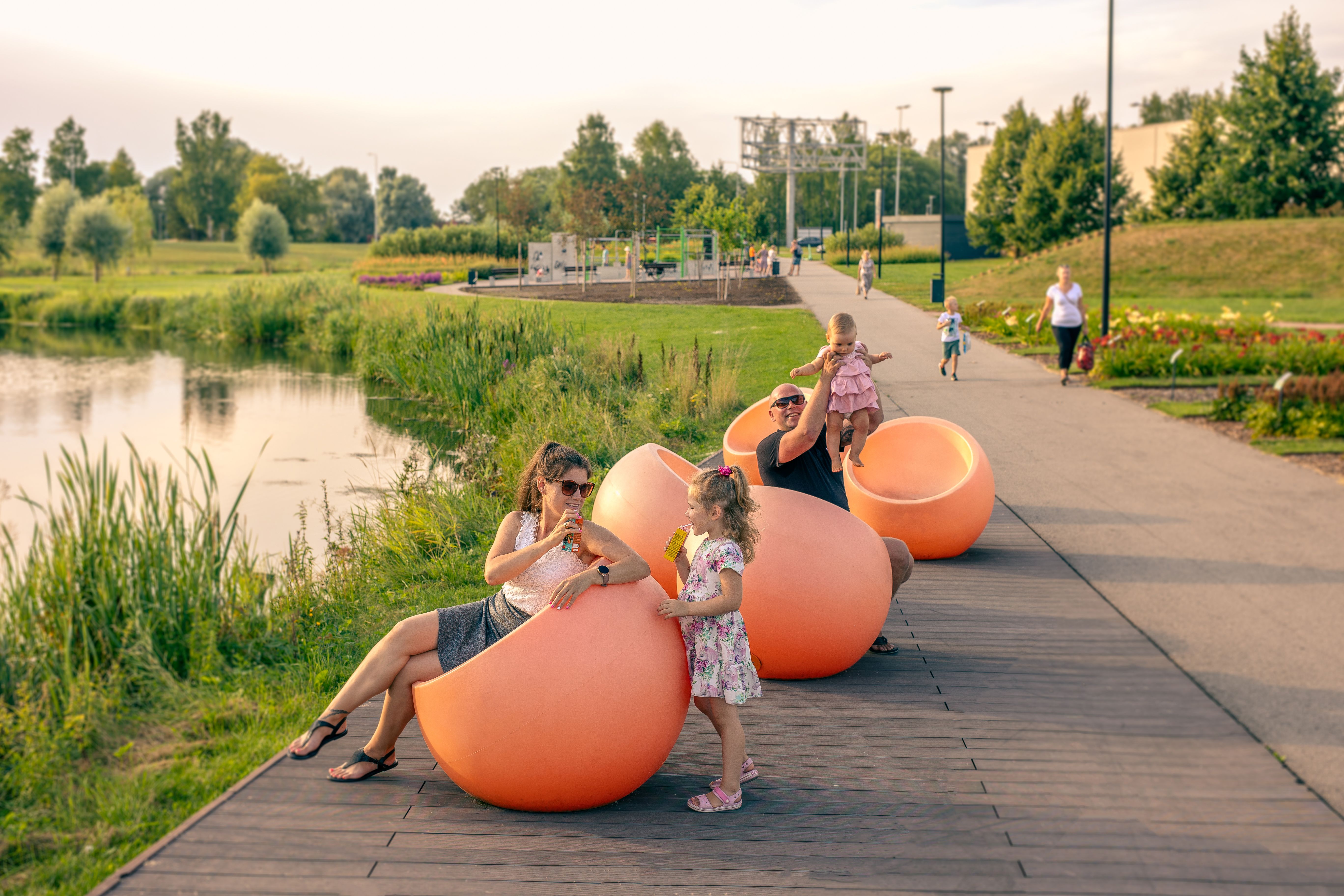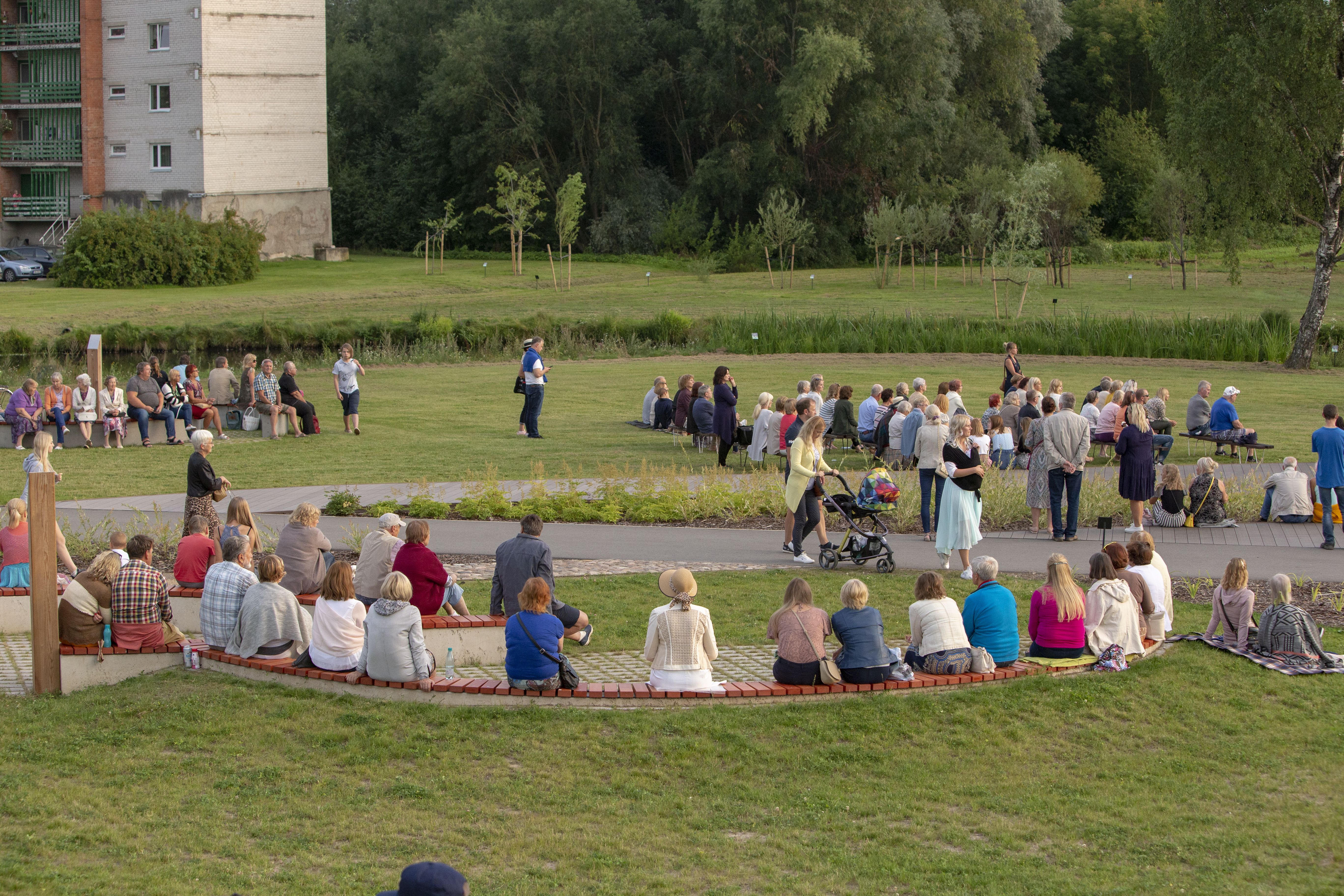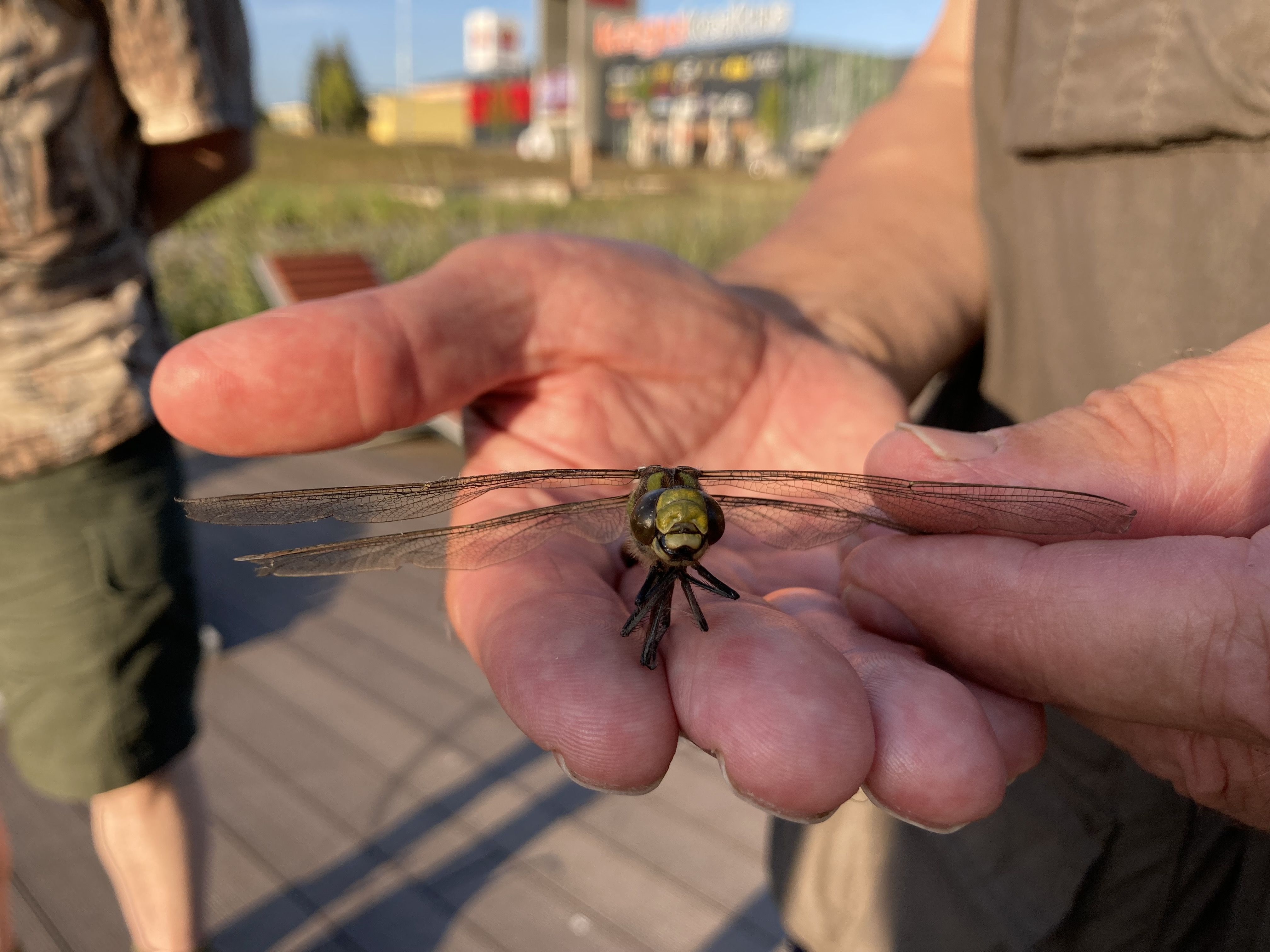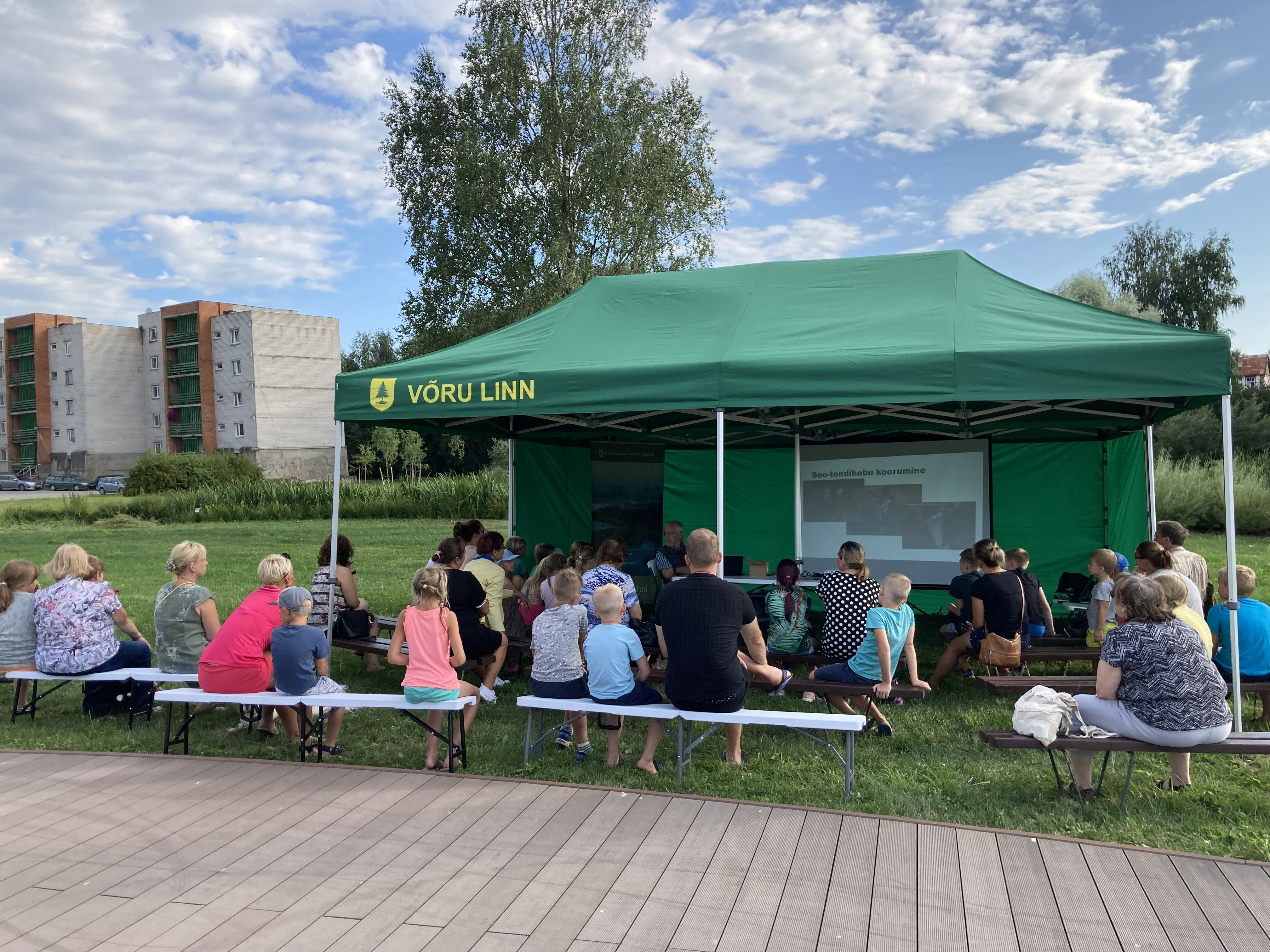Reconnecting with nature
Inclusive, liveable and biodiverse space
Koreli Park as a co-creative & green approach for shared space of natural & built environment
Koreli Park in Võru (ESTONIA) may be viewed as a vibrant urban oasis co-created by the municipality, local community & nature itself. Once a neglected area, it has been transformed into a thriving green space that embodies the NEB values: sustainability, inclusion & aesthetics. Park serves as a model of dynamic urban place where nature, design thinking & citizens’ will have successfully come together - a proof that inclusive urban planning can enhance both environment & quality of life for all.
Estonia
Local
Võru town
Mainly urban
It refers to a physical transformation of the built environment (hard investment)
Yes
2022-04-17
Yes
CBC - Estonian EU External Border Programme 2014-2020;
Estonian National Fund - Environmental Investment Centre ;
The Blue Hepatica charity campaign carried out by the Estonian Society of Wounded Soldiers.
No
No
As a representative of an organisation
In Võru, a small town in the South-East of Estonia with less than 11 500 inhabitants, the newly established Koreli park showcases the example of urban green space that has been co-creatively designed by the citizens and the urban nature itself. As a built environment it truly represents the NEB three core values: sustainability, inclusion and aesthetics. Developing Koreli Park is a key example of a quality urban living space that not only meets functional and ecological requirements but also fulfils design objectives when it comes to social and psychological needs such as a sense of belonging.
At the heart of the park there is Koreli Stream that runs through the town of Võru. The fate of the old stream has been complicated – during the Soviet era it was heavily polluted that is why it once was one of the worst water bodies in the town. Indeed, the re-vitalisation of Korel Park has been a long-term process, the restoration of the natural form of the streams being the first step (2006), since it was channeled during the Soviet times. A pedestrian road was then built (2018) along the banks of the stream to improve connections between various parts of the town and finally, a playful and diverse green area was created (2022) based on the ideas and wishes of the local people.
Koreli Park is not just a green urban area - rather, it is a meeting place for people of all ages and statuses. Here, families, both elderly and young people come together to rest, to do outdoor activities and learn from each other. The place is a living proof that when carefully planned and completed in the most inclusive manner a public space like this does raise the quality of a living environment for everyone. The area with its multi-level construction and a wide range of trees, shrubs & perennial flowers provides a habitat and shelter necessary for various insects and other organisms. Koreli park is somewhat a step towards the future - beautiful, sustainable and open to use for everyone.
At the heart of the park there is Koreli Stream that runs through the town of Võru. The fate of the old stream has been complicated – during the Soviet era it was heavily polluted that is why it once was one of the worst water bodies in the town. Indeed, the re-vitalisation of Korel Park has been a long-term process, the restoration of the natural form of the streams being the first step (2006), since it was channeled during the Soviet times. A pedestrian road was then built (2018) along the banks of the stream to improve connections between various parts of the town and finally, a playful and diverse green area was created (2022) based on the ideas and wishes of the local people.
Koreli Park is not just a green urban area - rather, it is a meeting place for people of all ages and statuses. Here, families, both elderly and young people come together to rest, to do outdoor activities and learn from each other. The place is a living proof that when carefully planned and completed in the most inclusive manner a public space like this does raise the quality of a living environment for everyone. The area with its multi-level construction and a wide range of trees, shrubs & perennial flowers provides a habitat and shelter necessary for various insects and other organisms. Koreli park is somewhat a step towards the future - beautiful, sustainable and open to use for everyone.
Social inclusion
Biodiversity and ecosystems
Quality time and well-being
Accessibility
Sustainability and circular economy
Koreli Park (~4ha) is a great example of how the sustainability objective of the NEB has been implemented. The construction of the site introduced on-the-spot recycling of raw materials & provided a new impetus to biological diversity issues, inspiring local communities to make its urban space more sustainable & functional. During the project, the principles of recycling have been a real focus of attention - the unused ground soil peeled off under other ongoing projects across the town, was gathered & upcycled and designed into artificial “hills” near the banks of Koreli. These have become popular slides among children during snowy winter times. Whereas reducing the waste production it equips the area with a new functional & more lively landscape. In addition, a special emphasis has been to promote biodiversity in the town. With the help of local people, 132 trees were planted in the park & nearly 2200 perennials & shrubs, now creating a versatile & viable green area.
One of the special features about the site is a kind of dendropark with willows comprising nearly 30 different willow species at the moment - undoubtedly, it is the most species-rich park formed by the willows in Estonia.
The park offers unique informal learning opportunities about the plants and their various forms (e.g. information boards). The willows are species that can withstand excessive moisture rich in nutrients and in this way they help to clean the ecosystem in the town - a real thing to keep in mind, especially considering the historical pollution of the stream. The success story of the construction of the Korel Park shows that even much more complex areas can be re-designed & developed into attractive & sustainable environments if actions & taken purposefully & the local community is engaged from the very start. The NEB objectives of combining sustainability, aesthetics & local community work have therefore been fully met in this public undertaking to develop a inspirational place.
One of the special features about the site is a kind of dendropark with willows comprising nearly 30 different willow species at the moment - undoubtedly, it is the most species-rich park formed by the willows in Estonia.
The park offers unique informal learning opportunities about the plants and their various forms (e.g. information boards). The willows are species that can withstand excessive moisture rich in nutrients and in this way they help to clean the ecosystem in the town - a real thing to keep in mind, especially considering the historical pollution of the stream. The success story of the construction of the Korel Park shows that even much more complex areas can be re-designed & developed into attractive & sustainable environments if actions & taken purposefully & the local community is engaged from the very start. The NEB objectives of combining sustainability, aesthetics & local community work have therefore been fully met in this public undertaking to develop a inspirational place.
The entire park itself is carefully designed by combining beautiful landscaping, functional outdoor facilities & opportunities that meet the needs & expectations of the people in town. Koreli park was created relying on the ideas of the community, which is why it does offer a variety of activities for different age groups. For elderly people a petanque square & cosy benches were built, for families with young children an entertaining playground is open at any time, & for people of all ages, a modern street workout & fitness area was constructed. Not only do these facilities decorate the green park but they also create new opportunities for social integration, helping to reduce isolation & loneliness. The main aesthetics of the site is based on a balanced design where natural & man-made objects function in a harmonious whole. Beautiful landscaping & well-maintained green areas provide both visual enjoyment & relaxing environment.
As a genuine grassroots initiative the municipality government together with local residents in Võru once came up with the idea to build a green & rich area covered with varied range of plants. The infrastructure project was also implemented in interaction with local citizens of whom nearly 400 contributed to planting, giving a new breath with their own hands. To date, there are nearly 132 trees in Koreli Park & 2200 perennials & shrubs allowing expanded habitats for birds, insects & small animals & providing year-round eye relief.
In addition, the year-round Koreli Park contributes to the sense of community & trust by providing opportunities for smaller events & bringing people together. All in all, Koreli Park is a lot more than just another urban green area - it is a connecting, emotionally valued & aesthetically enjoyable environment that continues to improve local people's well-being & enrich their daily lives.
The park was designed by one of the most recognized landscape architect in Estonia Ülle Grišakov &her team (Kivisilla Ltd)
As a genuine grassroots initiative the municipality government together with local residents in Võru once came up with the idea to build a green & rich area covered with varied range of plants. The infrastructure project was also implemented in interaction with local citizens of whom nearly 400 contributed to planting, giving a new breath with their own hands. To date, there are nearly 132 trees in Koreli Park & 2200 perennials & shrubs allowing expanded habitats for birds, insects & small animals & providing year-round eye relief.
In addition, the year-round Koreli Park contributes to the sense of community & trust by providing opportunities for smaller events & bringing people together. All in all, Koreli Park is a lot more than just another urban green area - it is a connecting, emotionally valued & aesthetically enjoyable environment that continues to improve local people's well-being & enrich their daily lives.
The park was designed by one of the most recognized landscape architect in Estonia Ülle Grišakov &her team (Kivisilla Ltd)
The urban greenery of Võru is designed so that everyone feels like being in the backyard of one’s home garden surrounded by a species-rich & aesthetically enjoyable environment. Korel Park also emphasizes accessibility, allowing each user to find a suitable place according to his/her abilities and interests. Indeed, the greatest value of the construced park is probably the involvement of local inhabitants.
Before the actual planning, a public survey was conducted on the Võru Town newspaper (~6500 mailboxes) to gather proposals & ideas from the people as well as local schools. Based on these wishes, a diverse & multi-purpose area was designed to meet the needs of different age groups & educational organisations. For elderly people a petanque square & cosy benches were built, for families with young children an entertaining playground is open at any time, & for people of all ages, a modern street workout & fitness area was constructed. Not only do these facilities decorate the green park but they also create new opportunities for social integration, helping to reduce isolation & loneliness.
In the course of establishing the park, joyful joint planting sessions were also held in which a total of 400 people participated (the eldest person at the age of 82).
In this immediate cooperation with both individuals & communities of Võru, the urban environment has eventually been transformed into a better habitat for both urban nature & people. That said, it is also impossible to overstate that the availability of the area’s rich natural habitats was improved with visitor infrastructure & better signage at the site.
To conclude, this chosen approach expresses the core principles of the involvement of the New European Bauhaus where active participation of the citizens does shape safe & aesthetic urban space.
It was build with the support of grants (Estonian EU External Border Programme, Environmental Investment Centre, Blue Hepatica charity campaign) & Võru town budget.
Before the actual planning, a public survey was conducted on the Võru Town newspaper (~6500 mailboxes) to gather proposals & ideas from the people as well as local schools. Based on these wishes, a diverse & multi-purpose area was designed to meet the needs of different age groups & educational organisations. For elderly people a petanque square & cosy benches were built, for families with young children an entertaining playground is open at any time, & for people of all ages, a modern street workout & fitness area was constructed. Not only do these facilities decorate the green park but they also create new opportunities for social integration, helping to reduce isolation & loneliness.
In the course of establishing the park, joyful joint planting sessions were also held in which a total of 400 people participated (the eldest person at the age of 82).
In this immediate cooperation with both individuals & communities of Võru, the urban environment has eventually been transformed into a better habitat for both urban nature & people. That said, it is also impossible to overstate that the availability of the area’s rich natural habitats was improved with visitor infrastructure & better signage at the site.
To conclude, this chosen approach expresses the core principles of the involvement of the New European Bauhaus where active participation of the citizens does shape safe & aesthetic urban space.
It was build with the support of grants (Estonian EU External Border Programme, Environmental Investment Centre, Blue Hepatica charity campaign) & Võru town budget.
In our opinion, the establishment of Korel Park has been a valuable endeavor of involvement of the local community while strengthening the local peoples’ ties to their home area and promoting citizens' initiative. In this respect, citizens themselves act like active creators and keepers of the public space.
The plantation campaign - truly a model experience of this kind of active involvement - gave locas a matchless opportunity to contribute directly to the park design, thus creating a more emotional connection with the new green area in town. As a very special personal story, we highlight an elderly lady who occasionally goes to the park and “talks” to her planted tree. Taking another new habit, some families with children go to see how their willow tree has grown time after time.
Participation in the planting sessions has created a strong sense of belonging - the park is perceived as a place of our own. As a result, people have also become much more vigilant about knowing what is going around them (acts of vandalism, for example). The urban space created has been very well received by the community also thanks to the range of project actions that helped to build public awareness, support and participation. In short, a number of project impacts to validate the chosen approach can be outlined:
While being an eye-catching landscape the park itself symbolizes th joint effort and grassroots co-operation. True enough, people tend to be more careful with space created with „hands-on“ experience.
Second, developing contemporary public areas like this is an experience of greater value since it has teached us good lessons in terms of maintaining urban spaces and taking future initiatives as regards quality design solutions.
Last not least, the whole story of Koreli Park shows that involvement could create a deep and lasting relationships between people and their public local space, making it a liveable environment of many qualities.
The plantation campaign - truly a model experience of this kind of active involvement - gave locas a matchless opportunity to contribute directly to the park design, thus creating a more emotional connection with the new green area in town. As a very special personal story, we highlight an elderly lady who occasionally goes to the park and “talks” to her planted tree. Taking another new habit, some families with children go to see how their willow tree has grown time after time.
Participation in the planting sessions has created a strong sense of belonging - the park is perceived as a place of our own. As a result, people have also become much more vigilant about knowing what is going around them (acts of vandalism, for example). The urban space created has been very well received by the community also thanks to the range of project actions that helped to build public awareness, support and participation. In short, a number of project impacts to validate the chosen approach can be outlined:
While being an eye-catching landscape the park itself symbolizes th joint effort and grassroots co-operation. True enough, people tend to be more careful with space created with „hands-on“ experience.
Second, developing contemporary public areas like this is an experience of greater value since it has teached us good lessons in terms of maintaining urban spaces and taking future initiatives as regards quality design solutions.
Last not least, the whole story of Koreli Park shows that involvement could create a deep and lasting relationships between people and their public local space, making it a liveable environment of many qualities.
Koreli Park serves as a great example of how multi-level cooperation & the involvement of different stakeholders come together to create a space that enriches the local area & brings the community together. Both planning & implementation of the site engaged local people, educational institutions, NGOs & funders at both national and EU level. Prior to the design, a broad-based public survey was launched via Võru Town monthly newspaper (free for all, ~6500 mailboxes) in order to grasp the expectations & needs the citizens might have.
In addition, teachers of natural sciences from local schools were involved to share their opinions on how the park as a future field study could be used so as to enhance pupils’ understanding of ecological concepts & urban green spaces. Consequently, special teaching equipment were also purchased for the schools & instructional materials for teachers were prepared. Special attention was paid to the needs intellectually disabled pupils (in the municipality there is Võru Järve School, a school for children with moderate and severe mental disabilities). Pavements with specially designed technology that were used on the surface of the park is a very clear example of this enabling children to learn about different materials and to possess their visual, tactile & vestibular senses.
One of the biggest community initiatives turned out to be the planting campaign in September 2019 with hundreds of people ready to contribute to the greenery of the park along the stream. The participation level vastly exceeded expectations of the organizers of the event so in order to ensure proper planting techniques & deliver valuable know-how to participants, gardening schools from the neigbouring regions were also called to assist the session.
We have shared our experiences & practical lessons with other municipalities as well since the design & construction of Koreli Park has also enjoyed a wider interest in other parts of Estonia.
In addition, teachers of natural sciences from local schools were involved to share their opinions on how the park as a future field study could be used so as to enhance pupils’ understanding of ecological concepts & urban green spaces. Consequently, special teaching equipment were also purchased for the schools & instructional materials for teachers were prepared. Special attention was paid to the needs intellectually disabled pupils (in the municipality there is Võru Järve School, a school for children with moderate and severe mental disabilities). Pavements with specially designed technology that were used on the surface of the park is a very clear example of this enabling children to learn about different materials and to possess their visual, tactile & vestibular senses.
One of the biggest community initiatives turned out to be the planting campaign in September 2019 with hundreds of people ready to contribute to the greenery of the park along the stream. The participation level vastly exceeded expectations of the organizers of the event so in order to ensure proper planting techniques & deliver valuable know-how to participants, gardening schools from the neigbouring regions were also called to assist the session.
We have shared our experiences & practical lessons with other municipalities as well since the design & construction of Koreli Park has also enjoyed a wider interest in other parts of Estonia.
The long process of establishing the Koreli Park included several areas of knowledge & disciplines that eventually made this multi-layered concept come to life:
Active involvement of local residents and key associations ensured that the park will meet the expectations (or even dreams) of local people as much as possible.
Education and social field - educational & community specialists made practical suggestions for the park to gain a long-lasting educational value added.
Environmental sciences and ecology - herbalists analyzed the existing habitat & grasslands types in the area & developed solutions to supporting biodiversity of the park, ecological balance and endurance.
Urban planning & landscape architecture - public space planners & landscape architects were involved to design a feasible spatial solution for the area, taking also into account people's ideas and everyday mobility needs, recreational facilities & aesthetic aspects.
Financial managers & decision-makers developed a distinctive budget plan and applied for funds to build and maintain the park.
Without great dedication & co-ordination it would not have been happened at all - people from different fields had to constantly interact with each other & exchange ideas. At one moment, the area itself seemed like a huge playfield with pieces of puzzle where different stakeholders & professionals came together for a greater good. For sure, the special value and outcome of the co-creative process is that the park was never about some plans being made behind closed doors, rather the project was significantly born out of the wishes and needs of the locals. This is also what makes Korel Park a lot more than just a green area in the centre of the town - it has become a commonly used recreational area that offers both aesthetic and mental and physical satisfaction whereas being a lively and diverse part of the community.
Active involvement of local residents and key associations ensured that the park will meet the expectations (or even dreams) of local people as much as possible.
Education and social field - educational & community specialists made practical suggestions for the park to gain a long-lasting educational value added.
Environmental sciences and ecology - herbalists analyzed the existing habitat & grasslands types in the area & developed solutions to supporting biodiversity of the park, ecological balance and endurance.
Urban planning & landscape architecture - public space planners & landscape architects were involved to design a feasible spatial solution for the area, taking also into account people's ideas and everyday mobility needs, recreational facilities & aesthetic aspects.
Financial managers & decision-makers developed a distinctive budget plan and applied for funds to build and maintain the park.
Without great dedication & co-ordination it would not have been happened at all - people from different fields had to constantly interact with each other & exchange ideas. At one moment, the area itself seemed like a huge playfield with pieces of puzzle where different stakeholders & professionals came together for a greater good. For sure, the special value and outcome of the co-creative process is that the park was never about some plans being made behind closed doors, rather the project was significantly born out of the wishes and needs of the locals. This is also what makes Korel Park a lot more than just a green area in the centre of the town - it has become a commonly used recreational area that offers both aesthetic and mental and physical satisfaction whereas being a lively and diverse part of the community.
The established park makes reference to some new cultural values in urban management which is again why this site represents more than a regular green area. While most local green spaces, parks etc are usually built according to norms - a modest landscaping, “obligatory” set of benches and sidewalks -, they went much further when designing the park in question. Here, re-thinking of the urban space was at the core. One of the biggest differences compared to conventional solutions was the way the locals were involved in the planning process. Public surveys are often held but very often their effects remain marginal, too. In the case of Koreli Park, people were really able to have a say - through proposals and planting works where everyone’s contribution was apparent and real. As a result, a park was born that is not just a municipal project or single policy result, but a part of the green network of Võru town created by the people themselves.
Another innovative aspect is the educational side of the initiative. Typically, city parks are meant primarily for taking walks and having some rest. However, this park invites you to curiously learn and explore the local (i.e green) environment. Having in mind the outdoor education needs of primary schools, study materials were developed for the target group, a water sampling platform was built on the shore, and small study areas were designed in the park. This kind of “class room” is seldom seen in city parks but in Võru this approach gives the place a whole new meaning. Moreover, Koreli Park is a great example of environmentally friendly urban planning. In other words, a careful selection of plants and trees was based on the scientific knowledge in order to support the local ecosystem and contribute to the adaptation of constant climate change.
Also, the park is unique because there are almost 30 different species of willows in the park - it is the largest willow dendropark in Estonia and possibly throughout all Europe.
Another innovative aspect is the educational side of the initiative. Typically, city parks are meant primarily for taking walks and having some rest. However, this park invites you to curiously learn and explore the local (i.e green) environment. Having in mind the outdoor education needs of primary schools, study materials were developed for the target group, a water sampling platform was built on the shore, and small study areas were designed in the park. This kind of “class room” is seldom seen in city parks but in Võru this approach gives the place a whole new meaning. Moreover, Koreli Park is a great example of environmentally friendly urban planning. In other words, a careful selection of plants and trees was based on the scientific knowledge in order to support the local ecosystem and contribute to the adaptation of constant climate change.
Also, the park is unique because there are almost 30 different species of willows in the park - it is the largest willow dendropark in Estonia and possibly throughout all Europe.
An inclusive and community-centered approach was used to develop Korel Park with various methods of local engagement of citizens and professionals:
1. A public survey was conducted in order to understand the expectations and needs of the locals as regards the development area. It gave everyone a good opportunity to share their thoughts and inputs on what should the park really look like.
2. Study trips, discussions and surveys among natural science teachers were launched to investigate further opportunities for outdoor learning in this area. In order to better integrate the park facilities with the national curriculum, learning methods and requirements were analysed and teaching materials elaborated for pupils at different levels of school. In addition, necessary equipment was obtained allowing for outdoor trainings. Right by the Koreli stream a safe wooden platform for water sampling was built and study areas built where teachers are able to hold outdoor lessons conveniently.
3. Activities related to landscaping the area were not only the work of professional landscapers, rather the aim was to be all in this together as a community. To this end a practical workshop was also organized with the help of regional Horticultural School lecturers on how to properly plant perennials, shrubs and larger trees. These joint planting sessions gave everyone a good chance to contribute to making the park with their own hands while learning new skills and participating in community co-creation.
1. A public survey was conducted in order to understand the expectations and needs of the locals as regards the development area. It gave everyone a good opportunity to share their thoughts and inputs on what should the park really look like.
2. Study trips, discussions and surveys among natural science teachers were launched to investigate further opportunities for outdoor learning in this area. In order to better integrate the park facilities with the national curriculum, learning methods and requirements were analysed and teaching materials elaborated for pupils at different levels of school. In addition, necessary equipment was obtained allowing for outdoor trainings. Right by the Koreli stream a safe wooden platform for water sampling was built and study areas built where teachers are able to hold outdoor lessons conveniently.
3. Activities related to landscaping the area were not only the work of professional landscapers, rather the aim was to be all in this together as a community. To this end a practical workshop was also organized with the help of regional Horticultural School lecturers on how to properly plant perennials, shrubs and larger trees. These joint planting sessions gave everyone a good chance to contribute to making the park with their own hands while learning new skills and participating in community co-creation.
The story of building Korel Park is like a strong source of inspiration, showing the ability of a small town to create something much more meaningful than just building a green area. It has really evolved the heart of the community, a learning environment and a liveable part of the urban space. As a success story it deserves to be shared since the methodology and bottom-up approach in creation of the park seems easily applicable to many other places, so as to bring benefits to different groups and individuals.
One of the most important lessons is the involvement of residents and stakeholders from the very start. The poll conducted through the local newspaper helped to gather a set of representative opinions and ideas so that the park could truly meet their needs. The joint planting event also showed how the community can be a major actor of its living environment - not a mere observer but a so-called agent in the spatial planning toolbox. In our opinion giving the decisive role to local residents is surely the experience worth sharing.
The educational approach was another key element that could be transferred to other cities, communities and schools. As a result of the development, Koreli Park became an open and informal nature classroom, where students can not only learn the theory but also do experiments and study themselves. The active involvement of Võru natural science teachers obviously confirmed the importance of linking the curricula with real life - specially designed teaching aids and guidance materials and the equipment makes outdoor learning exciting wherever taken.
Koreli Park also serves as a great example of environmental-friendly urban planning. Preserving the local ecosystem, developing natural water bodies and increasing biodiversity creates lasting values. In fact, such solutions can be implemented in any urban area to make public space more human and close-to-nature.
One of the most important lessons is the involvement of residents and stakeholders from the very start. The poll conducted through the local newspaper helped to gather a set of representative opinions and ideas so that the park could truly meet their needs. The joint planting event also showed how the community can be a major actor of its living environment - not a mere observer but a so-called agent in the spatial planning toolbox. In our opinion giving the decisive role to local residents is surely the experience worth sharing.
The educational approach was another key element that could be transferred to other cities, communities and schools. As a result of the development, Koreli Park became an open and informal nature classroom, where students can not only learn the theory but also do experiments and study themselves. The active involvement of Võru natural science teachers obviously confirmed the importance of linking the curricula with real life - specially designed teaching aids and guidance materials and the equipment makes outdoor learning exciting wherever taken.
Koreli Park also serves as a great example of environmental-friendly urban planning. Preserving the local ecosystem, developing natural water bodies and increasing biodiversity creates lasting values. In fact, such solutions can be implemented in any urban area to make public space more human and close-to-nature.
The development of Koreli Park is not just the construction of a green area for a small town like Võru – it has been the answer to a number of global challenges that affect communities around the world. The following highlights why Koreli Park is a stunning proof that global challenges can effectively be tackled by local action:
Global biodiversity loss affects both natural ecosystems & the quality of our lives. As for Koreli Park, the intention was to promote biodiversity by restoring valuable habitat types & green urban areas that in turn support vegetation and the balance of local ecosystems.
Due to the rapid development of urban areas green zones are under constant pressure whereas climate change impacts extreme weather across the countries. Thanks to the diversity-oriented & mixed use planning, Koreli Park helps to relieve heat waves & improve air quality for local residents almost in the heart of town.
In many cities worldwide the decline in community cohesion is increasingly perceived. However, construction of Korel Park represents a living example of how involvement of residents could strengthen the sense of community. People eagerly participated in planting activities & discussions, making the finalisation of the area a real joint effort.
Fostering environmental education is one of the key issues that all cities around the world are tackling with. Here again, this park was created not only as a recreational area but also as a town-wide learning space where school kids and enthusiasts can learn about plant species, nature conservation etc.
Universally, elderly people are in growing need for public space that’s safe and accessible & improves active lifestyle. This multi-use park was created for all generations providing a variety of health benefits by promoting physical activity, connection to nature & opportunities for community engagement. By doing so this kind of green space does help to prevent loneliness & health problems.
Global biodiversity loss affects both natural ecosystems & the quality of our lives. As for Koreli Park, the intention was to promote biodiversity by restoring valuable habitat types & green urban areas that in turn support vegetation and the balance of local ecosystems.
Due to the rapid development of urban areas green zones are under constant pressure whereas climate change impacts extreme weather across the countries. Thanks to the diversity-oriented & mixed use planning, Koreli Park helps to relieve heat waves & improve air quality for local residents almost in the heart of town.
In many cities worldwide the decline in community cohesion is increasingly perceived. However, construction of Korel Park represents a living example of how involvement of residents could strengthen the sense of community. People eagerly participated in planting activities & discussions, making the finalisation of the area a real joint effort.
Fostering environmental education is one of the key issues that all cities around the world are tackling with. Here again, this park was created not only as a recreational area but also as a town-wide learning space where school kids and enthusiasts can learn about plant species, nature conservation etc.
Universally, elderly people are in growing need for public space that’s safe and accessible & improves active lifestyle. This multi-use park was created for all generations providing a variety of health benefits by promoting physical activity, connection to nature & opportunities for community engagement. By doing so this kind of green space does help to prevent loneliness & health problems.
As a result of development of Korel Park, a diverse, liveable & community-driven public space was born just in the heart of Võru. However, the outputs and impacts of the project go far beyond the new green area established: it has transformed the normal use of the space, increased environmental awareness & joined the community together. Koreli Park perfectly embodies the thematic principles of New European Bauhaus - 'Reconnecting with nature' - offering a viable example of how nature, aesthetic design and the community of people can be harmoniously combined.
Results and outcomes of the development:
Koreli Park now serves as an accessible and aesthetically enjoyable area where both urban nature & human needs are taken into account. The park has diverse greenery, safe & accessible walkways, recreational areas & outdoor “classrooms”. Educational materials for schools have also been completed & topical events, incl. the planting sessions with hundreds of people have raised their awareness on nature conservation issues.
Impacts on the community and local environment:
Without a doubt the entire built-up area has increased the environmental awareness of local people as well as strengthened the sense of community. Instead of a regular green park it is considered as a meeting place where events & gatherings are usually organized. In ecological view, this has contributed to the increase in town-wide biodiversity providing valuable habitats for various plants, insects and birds.
Following the principles of sustainability, removed soil of the area was re-used in the construction, giving the materials a new life and reducing the ecological footprint.
The town of Võru has already shared its experiences with other municipalities, encouraging them to initiate similar projects. The story of Korel Park proves that when active people, educational spirit, nature and urban planning come together for common good, something great can happen that benefits many generations.
Results and outcomes of the development:
Koreli Park now serves as an accessible and aesthetically enjoyable area where both urban nature & human needs are taken into account. The park has diverse greenery, safe & accessible walkways, recreational areas & outdoor “classrooms”. Educational materials for schools have also been completed & topical events, incl. the planting sessions with hundreds of people have raised their awareness on nature conservation issues.
Impacts on the community and local environment:
Without a doubt the entire built-up area has increased the environmental awareness of local people as well as strengthened the sense of community. Instead of a regular green park it is considered as a meeting place where events & gatherings are usually organized. In ecological view, this has contributed to the increase in town-wide biodiversity providing valuable habitats for various plants, insects and birds.
Following the principles of sustainability, removed soil of the area was re-used in the construction, giving the materials a new life and reducing the ecological footprint.
The town of Võru has already shared its experiences with other municipalities, encouraging them to initiate similar projects. The story of Korel Park proves that when active people, educational spirit, nature and urban planning come together for common good, something great can happen that benefits many generations.

